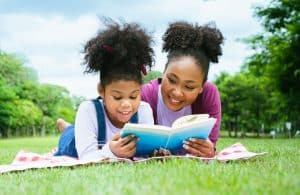The start of the school year has looked a little different for schools around Central New York as they made the transition to hybrid learning. Family Times recently talked to three local districts about how they prepared for that switch, how the day-to-day has changed for teachers and staff, and the reaction by families.
Syracuse City School District
The Syracuse City School District was one of the last in the area to transition to a hybrid model, opening schools for in-person learning on October 5 (it started the year remotely).
“It’s been a bit of a shift,” said Laura Kelley, the district’s chief academic officer. “It was great for the kids to connect with each other, to see their teachers and to get into the classrooms. It was very different, but the kids were great about all of the things we were asking them to do: wear their mask, stay behind the sneeze guards on their desk partitions and stay six feet apart. It went really well.”
Kelley said the preparation for the new hybrid model had a few different pieces. First was the safety aspect. Masks, hand sanitizer, disinfectant, paper towels and air purifiers were placed in every classroom, temperature takers were added to each school, and students were separated into pods in an effort to allow those families that opted for hybrid learning to attend in-person classes on the same days.
Then there was the academic aspect. The district hired demonstration teachers to film videos for different subjects and grade levels – teachers can then individualize those videos for their students – and added a student support service program for students and families who may be struggling. “We want to make sure that we’re responding to their needs and embedding a lot of social-emotional support, both in terms of counseling and outreach services, as well as in our instructional delivery,” Kelley said.
As part of its preparation, the Syracuse City School District also consulted with some of its neighboring districts. “We’re constantly calling our peers and asking questions, and really trying to learn from each other and troubleshoot,” Kelley said. “If one step is working, we definitely try to borrow everybody’s great ideas so that we can put good things in place for our kids.”
So, what has been the reaction so far?
“We have heard feedback from different families saying that their child was thriving in the remote setting without some of the typical day-to-day distractions that sometimes students face in school and that they want to keep it all remote,” Kelley said. “Some families are saying, ‘My child really benefits from being able to come in and be around his peers and learn some of those social skills.’ Some of our students who were maybe hoping to have lunch in the cafeteria together and socialize are disappointed that they haven’t been able to have those opportunities, but they knew from the beginning that we have to stay six feet apart, that we’re eating lunch in our classrooms at the elementary level, that we’re doing the grab and go at the secondary level. But they appreciate being able to see their teachers and see each other.”
Auburn Enlarged City School District
Superintendent Jeff Pirozzolo said that “hundreds of hours” of planning went into his district’s transition to hybrid learning. The Auburn Enlarged City School District completed the third step of its phased-in reopening in mid-October.
“We’re doing a couple of different things,” said Pirozzolo. “We’re running a hybrid model, K-12, where children come to school on A/B days, which goes Monday/Wednesday or Tuesday/Thursday. One of the reasons I set it up that way is I didn’t want students having school Monday and Tuesday and then not being in contact with teachers Wednesday, Thursday, Friday, Saturday and Sunday, and having to go five, almost six days, before they saw their teachers again.”
The other piece is virtual learning. Pirozzolo said that of the approximately 4,200 students in the district, about 1,000 of them opted to learn entirely online. In response, the district created a remote academy – it features 22 teachers that are devoted to virtual learning, and runs from Monday through Thursday. Friday is a planning day for all teachers in the district, the majority of which are now teaching dual lessons.
“Not only are they doing the in-person instruction, they’re also have to work on their Google classroom, uploading all the information, the lessons, the work,” said Pirozzolo. “We have teachers that have been teaching for 25 or 30 years that say they’ve never ever done this much planning and preparation work. The amount of planning our teachers are doing is just incredible.”
As for families in the district, the reaction has been mixed so far.
“I was on the phone until 8:30 p.m. last night calling families,” he said. “Some are very happy with the hybrid and it’s working well for their families, but I would say for the majority of the parents, it’s not a good thing because kids need to be in school five days a week, especially when you have elementary children and you work…Because we’re packed into our buildings, and transportation, we just can’t do five days a week. Parents are frustrated with that. But we do get a lot of positive phone calls about how wonderful the teachers are and how responsive they are.”
East Syracuse-Minoa Central School District
Superintendent Donna DeSiato said her district’s preparation began with community awareness.
“We put examples out there so that they would understand that it would mean that part of the week, students would be in person, in school, and the other part of the week they would be in virtual learning,” she said, “But that five days a week there would be a learning model.”
The district ultimately decided that students in grades K-5 would attend in-person classes five days a week, while students at the middle and high school levels would follow a hybrid model and attend in-person classes two days a week (unless, of course, they opted for 100% virtual learning).That required the district to look at the capacity of the schools, and programming and scheduling needs (such as putting family members in the same cohort). At the same time, a re-opening team was activated at each building in the district – teachers and administrators that examined the curriculum, and how to ensure it met the requirements set forth by the state education department. “There was a lot of very in-depth logistics going on,” said DeSiato. Like other districts in the area, the East Syracuse-Minoa Central School District followed a phased-in reopening.
DeSiato said that students and families in the district have adjust-ed to the new learning model.
“Families have been very supportive in recognizing that we are in a pandemic, and therefore, the highest priority is the health and safety protocols,” she said. “In order to deliver the instructional model that we’re delivering, we have to have very clear guidelines and protocols for the size of the group, social distancing, the wearing of masks, and respiratory hygiene. All of that is going on continuously. We’re also able to provide flexibility for families, which they very much appreciate because there are some families where that child may not be able to be in a distance learning classroom during the typical school hours and they have to do that later in the day when their family is able to provide that support. So, there’s a great deal of flexibility going on, a great deal of meeting family needs.”





